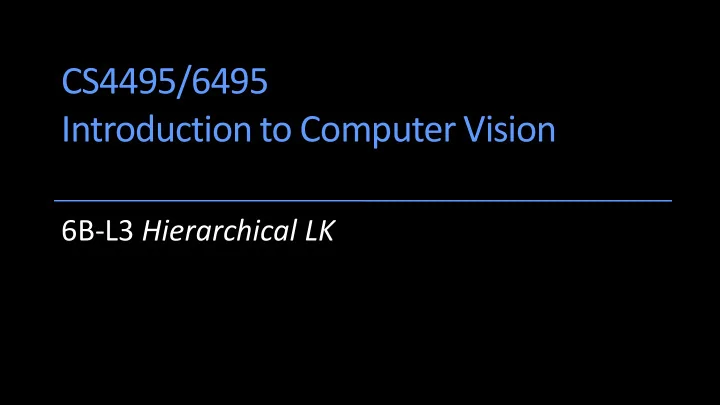

CS4495/6495 Introduction to Computer Vision 6B-L3 Hierarchical LK
Revisiting the small motion assumption • Is this motion small enough? • Probably not – much larger than one pixel • How might we solve this problem? Garden image sequence #1
Revisiting the small motion assumption • Is this motion small enough? • Probably not – much larger than one pixel • How might we solve this problem? Garden image sequence #2
Optical Flow: Aliasing actual shift estimated shift nearest match is nearest match is correct (no aliasing) incorrect (aliasing) To overcome aliasing: coarse-to-fine estimation
Reduce the resolution!
u=1.25 pixels u=2.5 pixels u=5 pixels u=10 pixels image 1 image 1 image 2 image 2 Gaussian pyramid of image 1 Gaussian pyramid of image 2
run iterative L-K warp & upsample run iterative L-K . . . image 1 image 2 Gaussian pyramid of image 1 Gaussian pyramid of image 2
Optical Flow Results *From Khurram Hassan-Shafique CAP5415 Computer Vision 2003
Optical Flow Results *From Khurram Hassan-Shafique CAP5415 Computer Vision 2003
Detour: Multi-scale analysis, image pyramids
1/8 1/4 Throw away every other row and column to create a 1/2 size image: image sub-sampling S. Seitz
Bad image sub-sampling 1/2 1/4 (2x zoom) 1/8 (4x zoom) Aliasing! What do we do? S. Seitz
G 1/8 G 1/4 Gaussian 1/2 Solution: Filter the image, then subsample S. Seitz
Subsampling with Gaussian pre-filtering G 1/8 Gaussian 1/2 G 1/4 S. Seitz
Image Pyramids Known as a Gaussian Pyramid [Burt and Adelson, 1983]
“Band - pass” filtering Gaussian Pyramid (low-pass images) Laplacian Pyramid (subband images) These are “ bandpass ” images (almost).
Laplacian Pyramid Need this! Original image How can we reconstruct (collapse) this pyramid into the original image?
Laplacian Pyramid Need this! Original image How can we reconstruct (collapse) this pyramid into the original image?
Expand Reduce Need G k to reconstruct
Reduce and Expand Reduce Apply “5 - tap” (1 4 6 4 1)/16 separable filter to make reduced image.
Reduce and Expand Expand Reduce Apply “5 - tap” (1 4 6 4 1)/16 Apply different “3 - tap” separable filter to make separable filters for even and reduced image. odd pixels to make expanded image...
Apply different “3 - tap” separable filters for even and odd pixels to make expanded image. Even Odd Coarser Finer
L 0 L 2 L 4 Reconstructed
Applying pyramids to LK
L K Warp Expand x2 Reduce Reduce L K War p Reduce Reduce x2 Expand L K War p Final <u(x,y), v(x,y)> Expand x2
Hierarchical LK 1. Compute Iterative LK at level K 2. Initialize 𝑣 𝐿+1 , 𝑤 𝐿+1 = 0 at size of level K+1
3. For Each Level i from K to 0 𝑞 , 𝑤 𝑗 𝑞 flow • Upsample (EXPAND) 𝑣 𝑗+1 , 𝑤 𝑗+1 to create 𝑣 𝑗 fields of now twice resolution as level i+1 𝑞 , 𝑤 𝑗 𝑞 by 2 to get predicted flow • Multiply 𝑣 𝑗 • Warp level 𝑗 Gaussian version of 𝐽 2 according to predicted flow to create 𝐽 2 ′
3. For Each Level i from K to 0 • Apply LK between 𝐽 2 ′ and level 𝑗 Gaussian version of 𝜀 , 𝑤 𝑗 𝜀 (the correction in flow) 𝐽 1 to get 𝑣 𝑗 Add corrections to obtain the flow 𝑣 𝑗 , 𝑤 𝑗 at i th level, i.e., 𝑞 + 𝑣 𝑗 𝜀 𝑣 𝑗 = 𝑣 𝑗 𝑞 + 𝑤 𝑗 𝜀 𝑤 𝑗 = 𝑤 𝑗
Optical Flow Results *From Khurram Hassan-Shafique CAP5415 Computer Vision 2003
Optical Flow Results *From Khurram Hassan-Shafique CAP5415 Computer Vision 2003
Sparse LK • The Lucas-Kanade algorithm described gives a dense field, (𝑣, 𝑤) everywhere. • But we said that we only want to solve LK where the eigenvalues are well behaved.
Sparse LK • “Sparse LK” is basically just that: hierarchical applied to good feature locaitons. • OpenCV LK used to be dense – then became sparse!
Start with something similar to Lucas-Kanade + gradient constancy + region matching + energy minimization + keypoint matching (long- with smoothing term range) Large displacement optical flow Brox et al., CVPR 2009
Recommend
More recommend